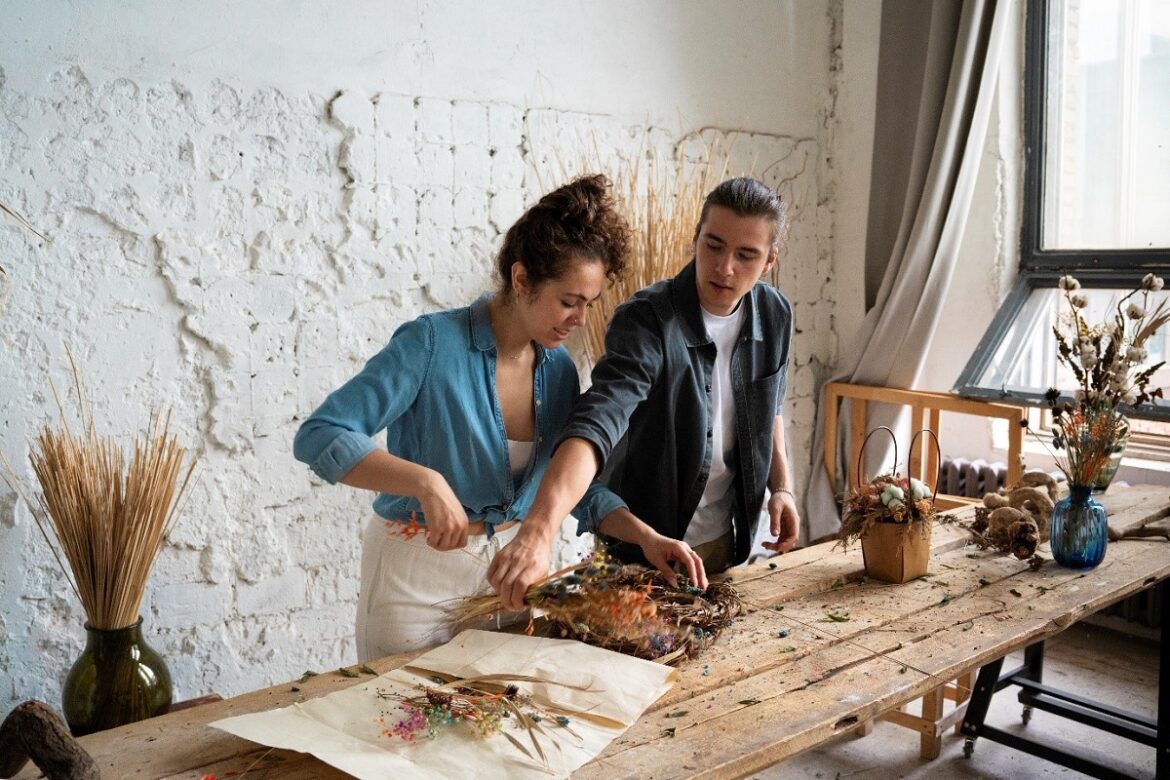DIY Home Decor: Easy Projects to Personalize Your Space
A unique home, one that narrates a different tale from the one on offer, is an exceptional feat in an increasingly mechanized world of furniture and décor. A wonderful opportunity to provide the home atmosphere with personality, creativity, and flair is one offered by DIY decorations. If you are new to DIY home décor or have only dabbled with it before, you will find innumerable opportunities of stunningly transforming your living environment with totally easy and inexpensive methods.
DIY home makeover is literally for making your different corners of space liveable, from your living room to the warmth of your bedroom, your kitchen, or even the outside areas. This kind of project can be enjoyed in many ways; you don’t have to be a professional designer or spend a lot to create a space that feels chic, cozy, and tailored to your taste; with a few tools, some imagination, and some creativity, a room can easily be rejuvenated and personalized.
Why DIY Home Décor Matters
There is a charm to creating something with one’s hands in a period of mass production; perhaps, it adds that element of authenticity to any space. The options for DIY become endless, allowing you to give your home a unique representation of your personality, lifestyle, and values. Stress reduction and improved mood are said to be benefits of behaviours stimulating creativity, such as decorating your home.
Essential DIY Tools for Every Home Décor Project
A set of the right tools is essential before any step is taken on a DIY home décor project. These basic tools will guarantee that these projects are accurate, efficient, and professional-looking. So, let’s explore each of these tools in greater detail:
- Measuring Tape & Level – For Precision and Balance
- Glue Gun & Adhesives – A Must-Have for Nearly Every Project
- Utility Knife/Box Cutter – To Neatly Cut Through Paper, Fabric, or Foam
- Paintbrushes & Foam Rollers – For Applying Chalk Paint or Stains
Project 1: Upcycled Furniture with Chalk Paint
Chalk paint has good adherence to most surfaces while drying quickly, thus being versatile enough for different finishes. The colours available are enough for all shadings, with each finish able to be distressed for that shabby-chic effect or left smooth for more modernity.
Step-by-Step Guide
Step 1: Choose the Right Piece of Furniture
For selecting old furniture, use something solid in construction like a chair, table, or dresser. Make sure it is sturdy enough, such that after the transformation, it can hold more processes.
Step 2: Clean and Prep the Surface
It is highly desirable to remove the old paint from any restored lounge chair as the old paint gets chipped and peeled when further objects are put down or adjusted.
Step 3: Apply the First Coat of Chalk Paint
Invest a little patience in applying the first thin coat of chalk paint with a quality brush because you should leave it to dry completely before doing a second coat for evenness.
Step 4: Apply a Protective Finish
Help keep a durable and smooth finish for your paint by applying finishing wax or a polyurethane topcoat, which adds protection.
Project 2: Floating Shelves for Style and Function
Floating shelves are somewhat sleek; they save space, offer versatile configuration options, and thus can look contemporary within a space where they will find support along with the wall. Floating shelves are also very versatile, installed in virtually every room of the house, thus utilizing wall space for functionality and decoration.
Step-by-Step Guide to Building Floating Shelves
Step 1: Choose Your Materials
Choose tough materials for your shelves such as wood planks or plywood for the shelf base. Brackets will also be needed to support the weight of the display items even though the floating feeling is achieved by hiding the brackets inside the wall.
Step 2: Measure and Mark the Wall
Length and height are taken where shelves will be mounted. With the level, make sure the shelves will be straight when installed. Mark off the positions for the brackets on the wall, ensuring they are evenly spaced for balance.
Step 3: Install Brackets
Attach the brackets onto the wall using a drill with appropriate wall anchors, or screws. In fastening the brackets, make sure to fasten them tight on to the studs for further support, especially when heavy items will be stored on the shelf.
Step 4: Cut and Prepare the Shelves
Saw a supply of wood planks to any desired length or take them to your hardware store and have them cut. Sand the edges to a smooth finish, and stain or paint the wood if you wish to suit your decor.
Step 5: Attach the Shelves
With the brackets mounted and the shelves prepared, carefully slide the shelves onto the brackets. Make sure they are in position, level, and stable. Depending on the design, you may have to screw the shelf into the bracket system or let them sit directly on the weight of the shelf.
Project 3: Peel-and-Stick Wallpaper Accent Walls
Peel and stick wallpaper adds to one’s convenience for there is no requirement of pasting and easy application and removal without leaving any marks on the walls of the house. It offers many varieties from geometric patterns to florals or textures for focalization according to the individual’s taste. This would suit renters and those who love changing their spaces from time to time.
Step-by-Step Guide
Step 1: Choose Your Wallpaper
Choose the peeling wallpaper that goes best with your style and fits into your space. Think about the styles, textures and colours that match with your current situation.
Step 2: Measure the Wall
You can check the measurement of your wall with a measuring tape. You need this to anticipate how many rolls you’ll need and how to prepare for pattern alignment.
Step 3: Prep the Wall
There must be a wall that is clean, dry, and smooth. A mild cleaning solution would help in getting rid of dust, dirt, grease, and other foreign matter. This smooth surface would help the wallpaper hold properly onto it.
Step 4: Apply the Wallpaper
Tarting from the top, peel off back a few inches of the wallpaper, pressing it against the wall so you can slowly peel off the backing and smooth the paper against the wall with your hands or even a squeegee to eliminate bubbles. Work in sections, ensuring the wallpaper aligns nicely and is straight.
Step 5: Trim Excess and Finish
After applying the wallpaper, cut away any excess along the edges with a utility knife. Press down on the edges with a cloth to ensure that they adhere firmly. Smooth out any seams for a more seamless appearance.
Project 4: Custom Canvas Art and Wall Hangings
Customized canvas artwork lets you design according to your own sense of art and needs. It’s a cheap way to bring into your house real, high-quality personal art. Besides being something that can easily be changed with time as you play with the various techniques-from abstract designs to nature paintings or motivational quotes-creating a fun project altogether.
Step-by-Step Guide
Step 1: Choose Your Canvas and Materials
Select from a wide preferably space that can hold an empty canvas: however, a canvas panel is ideal for a small project. Take your acrylic paints along with the necessary brushes, stencils, and painter’s tape for any clean line or shape you may have in mind.
Step 2: Plan Your Design
Decide on the design you wish to make: a straightforward geometric repetition or something more capable, like a painting or typography. Lightly sketch a design on the canvas or stencil your exact shapes.
Step 3: Apply Paint or Design Elements
Start painting your design with your brushes. Use palette knives for a textured effect. If you happen to include a quote, consider stencils or vinyl lettering so the text can be properly finished for a professional look. Be creative applying colours and explore all techniques that could be best for the intended goal.
Step 4: Let It Dry and Add Details
After the foundation design is achieved, the next step is to wait and let it completely dry. Then, you can begin adding your final touches; additional applications of paint, outlines, or trimmings such as gold leaf or glitter for pizazz.
Step 5: Mount or Hang the Canvas
Once the paint dries, hang or frame the canvas. You can use picture hangers or wall-mounted brackets to hold the canvas if you prefer a floating frame effect. For a traditional effect, you can add a wooden frame to it or hang it in an already-built frame.
Project 5: Entryway Makeover with a Personal Touch
Incorporating personal style and creating a welcoming environment, the entryway is the first impression of guests into the home and should be a good space for showcasing. An entryway set nicely creates an atmosphere for the rest of the home; a few personal touches can make it a functional, appealing space. This project will take you through some simple updates that will enhance your entryway while honouring your own style.
Step-by-Step Guide
Step 1: Declutter and Assess the Space
One begins to clear the entry area of clutter. Old shoes, coats, or artifacts that are not a part of the present scene must be ejected from the space. Once the area is decluttered, it is time to assess storage needs of this space-do you need space for shoes, coats, bags, or keys? Depending on the function of the space, add some decorations.
Step 2: Add Functional Storage
Get an entryway coat rack, shoe rack, or bench to provide a good storage option. An under-bench storage seat is perfect for organizing shoes or bags and allowing people to sit down when putting on shoes. You can also hang coat hooks on the wall or set up a lovely freestanding coat rack to really add some function as well as style to the space.
Step 3: Personalize with Artwork or Mirrors
Bring in a personal touch with framed artwork, family portraits, or a mirror. A mirror opens a space, but it also fulfils a functional aspect: checking oneself before stepping out of the house. Choose art that you’ll reflect your soul, whether it’s a striking quote, a landscape or even abstract art.
Step 4: Incorporate Lighting
Great decor makes the entryway light and bright. Install beautiful hanging lights or illuminate the walls with wall sconces. Warm, soft lighting can make a place feel cozy and inviting. Alternatively, a table lamp or string lights can define the area with a cozy touch.
Step 5: Add Decorative Elements
Lastly, finish up with decorations to augment the general feel of the space. A welcome mat with a humorous or heartfelt message creates a friendly ambience. Plants or a vase of fresh flowers add colour and vibrancy. Little suggestions, such as a decorative tray for keys or a custom-made welcome sign, can beautifully tie in the rest of the space.
Final Thoughts
Well-designed entryways set the whole tone for the house, but for everyone, personalizing them could make them more welcoming or functional. Some changes such as storage solutions, artwork, or new lights, rather small changes really can impact an entryway’s atmosphere much. A makeover into an entryway brings not just function but also style just as one step in.
Consider it worthwhile to personalize this area because your house is meant to remain spectacular in its initial impression, setting the stage for the rest of your decorations. Be creative and take it easy while transforming this most ignored part of your house into a one meant for enjoyment.








